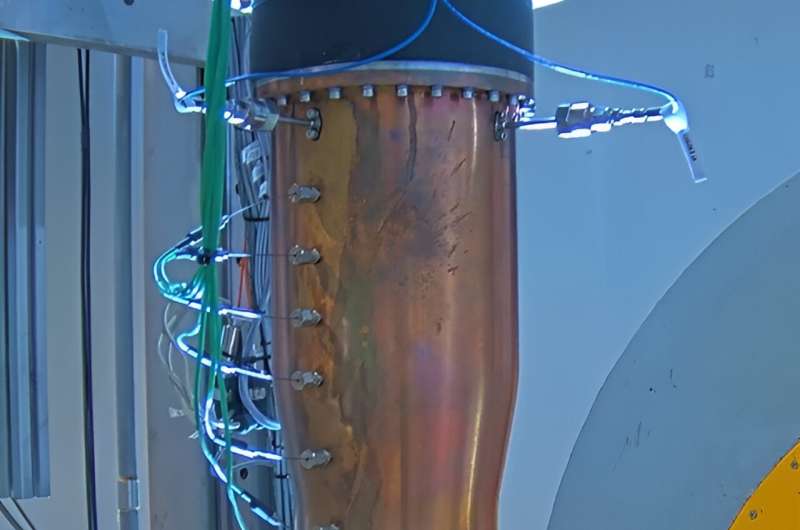This article has been reviewed according to Science X's editorial process and policies. Editors have highlighted the following attributes while ensuring the content's credibility:
fact-checked
trusted source
proofread
Promising early tests for variable-thrust landing engine

As part of ESA's Future Launchers Preparatory Program (FLPP), the first phase of hot-fire tests has been completed on a new, variable-thrust rocket engine in Warsaw, Poland. The engine is being developed by a Polish consortium investigating new designs for propellant valves and injectors that can vary the thrust of rocket engines powered by more sustainable and storable propellants. Such engines have great potential for use in future space missions and reusable rockets.
The new engine is called the Throttleable Liquid Propulsion Demonstrator (TLPD), it is now being dismounted and inspected, with the results being analyzed at the site of prime contractor Łukasiewicz Research Network—Institute of Aviation (Lukasiewicz-ILOT) in Poland, with partners Astronika and Jakusz SpaceTech, before the next phase of testing begins.
Liquid propellants that last
The throttleable engine includes a newly designed fuel injector and control valves. With a thrust of 5kN (compared to the Ariane 6 upper stage engine's thrust of 180 kN), the TLPD engine is perfect for the upper stage of smaller rockets, for in-space vehicles, for launcher kick-stages and exploration missions. The ability to modify its thrust makes it also very interesting for landing spacecraft on Earth, the moon and beyond.
The new rocket engine is powered by storable propellants hydrogen peroxide and ethanol, which are safer and less toxic than others currently in use (such as hydrazine and nitrogen tetroxide). Compared to cryogenic propellants, like liquid oxygen and hydrogen, storable propellants require no active cooling measures and will not diminish between subsequent engine firings.
Rocket engines powered by storable propellants can have long lifetimes in space and are easy to reliably and repeatedly ignite during missions that last many months. Cryogenic propellants also require energy to begin combustion, provided by an "igniter," whereas the TLPD propellants ignite upon contact with each other, making the engine simpler and more reliable.
At heart: New electronically controlled valves and fuel injector
The main goal of the current throttleable engine project is to test a newly developed system of valves and a movable "pintle" injector—a type of propellant injector used in "bipropellant" rocket engines—all commanded by an electronic control system.
The valves ensure the appropriate rate of propellant flows into the combustion chamber—the higher the rate, the greater the thrust. The fuel injector mixes the two propellants (the ethanol fuel and hydrogen peroxide oxidizer) while they are injected at high pressure into the chamber, maintaining stable combustion as their rate varies coming through the valves. All of this ensures an efficient and controlled combustion process can take place.
Next: Going full throttle
The TLPD engine has been designed to be throttled down to 20% and up to 110% of its optimal level of thrust. Such "deep" throttling, i.e., the ability to really vary the engine's power, is necessary for landing rocket stages on Earth, or spacecraft on the moon or other planetary bodies.
The hot fire tests just completed in Phase A were originally planned to be purely static, testing the engine's ability to fire at a constant rate. The engine was fired 17 times for up to 10 seconds, while the amount of fuel and oxidizer flowing in was kept constant.
The initial results were so promising that teams decided to move onto the next phase earlier than planned—dynamic throttling. The engine was fired up twice again, each time for 15 seconds, during which the thrust was varied down to 20% and up to 80% of its optimal level.
Once the results have been analyzed, the TLPD engine will be remounted and the full scope of planned dynamic tests will begin, with even longer firing durations. This set of tests is expected to start in October and will really put the "throttleability" of the engine to the test.
ESA's Future Launchers Preparatory Program and Lukasiewicz-ILOT are now in discussions about continuing the project, building on these test results and working towards the design of an overall throttleable flight engine.
Provided by European Space Agency





















